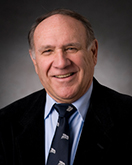
Dennis K. McLaughlin, Ph.D.
Professor of Aerospace Engineering
230 Hammond Building
Penn State University
University Park, PA 16802
Phone: 814-865-2560 / Fax: 814-865-7092
E-mail: dkm2@psu.edu
Dennis McLaughlin is a man with a plan – more than one, in fact. For every project the Penn State professor of aerospace engineering leads, he devises a Gantt chart using the method he learned as a graduate student at the Massachusetts Institute of Technology. Over the years, he has written scores of them and helped students write many more, but he is still learning about the process and improving his command of it.
McLaughlin’s commitment to planning is part and parcel of his work overseeing experiments in aerodynamics and aeroacoustics that focus on the measurements that connect flow instabilities and turbulence to radiated noise. Performing experiments requires looking ahead so that parts can be delivered and fabricated on time, and it requires working with people, which means coordinating, leading and managing. According to McLaughlin, teamwork is as important to successful engineering today as brains, experience and hard work.
“We are in a people-interactive job,” he said. “It’s a high technology job, but there is tons of interaction, more teamwork even than there was 10 or 15 years ago. This emphasis is nationwide and in fact correlates to the demands of a global work force. I believe that with good management and leadership, the whole becomes greater than the sum of its parts.”
McLaughlin is currently overseeing experimental work for three projects, two of them focused on aeroacoustics and one on a new kind of VTOL (vertical takeoff and landing) vehicle colloquially known as an air jeep.
The goal of the first project is to reduce jet engine noise, a significant problem for communities near air fields and a worse problem for military personnel, particularly those who work on the flight decks of aircraft carriers. Along with his colleague Professor Phil Morris and a team of students, McLaughlin is trying out various strategies to quiet the engines that power the F/A-18 and F-35 fighter aircraft. McLaughlin’s job is to measure and collect a database of the noise emitted from a 1/40th-scale replica of an engine’s propulsor when air is blown through it in an anechoic chamber. To do this, the experiments deploy a moveable boom with multiple rotating microphones as well as optical devices to measure turbulence.
Once the numbers have been collected, they are sent back to Professor Morris who uses them to refine his theoretical models and to devise new ones for future testing.
The second aeroacoustics project seems an unlikely one – quieting wind turbines. Wind energy is touted as environmentally friendly, but critics say the turbines can be unsightly, harmful to birds, and loud. McLaughlin and his team are addressing the third concern and will look at quieting strategies, including changing the shape and possibly adding winglets to the turbine rotor.
Penn State erected a wind turbine on hillside property near Mt. Nittany three years ago, but it fell into disuse. Now, the Aerospace team has refurbished it and is performing an assortment of aerodynamic experiments. A second, larger turbine system which will allow more aerodynamic and aeroacoustic experimentation, is to be procured soon.
The third project, just two years old in the fall of 2009, is development of the VTOL (vertical takeoff and landing) vehicle, also known as a fancraft or an air jeep -- a craft that looks like something out of a sci-fi comic book of the 1940s but has practical potential. Powered by two ducted fans and two propulsors, the fancraft takes off vertically but lacks a helicopter’s rotor, which enables it to operate in close quarters – next to tall buildings and cliff faces, for example. Pennsylvania’s own Piasecki Corp. developed a similar vehicle 50 years ago, but the program subsequently stalled. The 21st-century project is being carried out in cooperation with an Israeli company.
“Right now, the aircraft hovers okay, and then it kind of meanders,” McLaughlin said. “We are hoping to achieve forward speeds of about 100 mph, but we have a ways to go yet.”
So far, McLaughlin’s team has built two miniature ducted fan models and flown them in a wind tunnel. These test flights yield performance data that in time will help the applied engineers in Israel make decisions about the potential for producing a fancraft fast enough to be commercially viable.
Professor McLaughlin may believe in planning, but his career in aerospace came about almost by accident. As an undergraduate studying mechanical engineering at the University of Manitoba, he had a summer job at a power generation plant and one day happened to spot a Massachusetts Institute of Technology catalog on a shelf.
“I have no idea what it was doing there,” he said. “But I thought it looked interesting. As a child, I had always liked looking at books and magazines on cars and airplanes in the library.”
After McLaughlin graduated first in his class, M.I.T. accepted him into its graduate program in aeronautics and astronautics from which he earned his Ph.D. in 1970. McLaughlin taught for 11 years at Oklahoma State, worked as a visiting engineer at NASA then as a group manager at Dynamics Technology for five years. While he liked the collegiality of working in industry, he missed teaching, and came to Penn State in 1986. He served as head of the department of aerospace engineering until 2004.
Today McLaughlin brings his commitment to the plan to the classroom, teaching -- among other things -- an upper-division undergraduate course in project management. At the same time, he brings his pragmatic, engineering approach to teaching.
“There is a wide gap between what I know after all these years and what the students know,” he said. “My challenge is to narrow it. When they do something dorky, I call them on it. When they do something right, I pile on the applause.”
